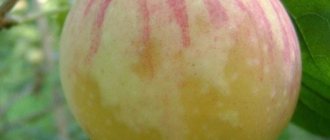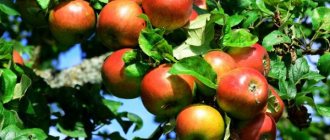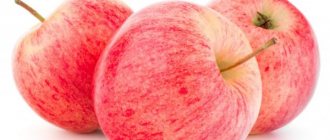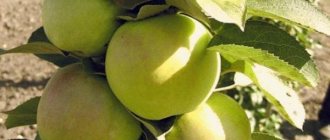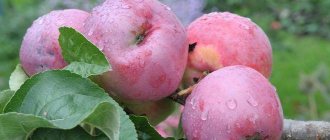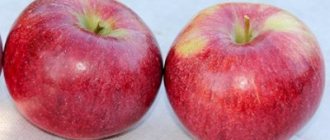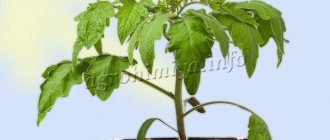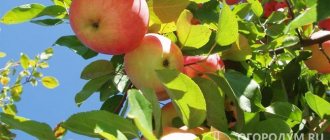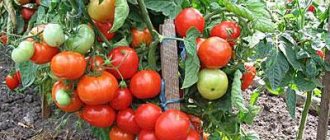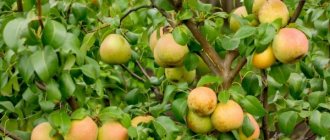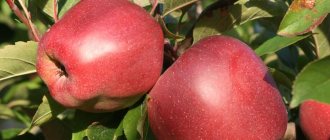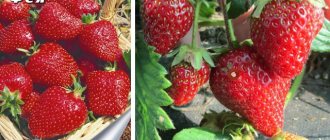Apple trees are popular in industrial and amateur gardens .
Gardeners strive to obtain high yields while investing less money and labor effort.
Developments of domestic breeders allow us to choose the best modern varieties of apple trees for this :
- Zoned , intended for cultivation in certain climatic conditions;
- Easily adapt to the characteristics of soil , topography, humidity and seasonal temperatures;
- Resistant to specific diseases and pests;
- Long-lived and high-yielding;
- With large, shelf-stable marketable fruits.
These are the qualities that the apple tree variety Yablochny Spas has.
It is perfect for a future garden , rich in harvests and not requiring labor-intensive care.
Description
Apple tree Apple tree is the pride of modern selection . Bred in 2004 by specialists of the All-Russian Research Institute for Breeding Fruit Crops (Orel), registered by the State Register in 2009.
Obtained by polyploidy . Apple trees usually have 2 sets of chromosomes, one each from the mother and father plants.
Varieties with three and four such sets have been obtained by artificial crossing.
Triploid varieties produce the largest number of large, juicy marketable fruits . This is exactly what the apple tree of the Yablochny Spas variety is like.
The variety is summer, the fruits are not intended for long-term storage .
IMPORTANT! The Apple Spas variety is absolutely not susceptible to scab and is resistant to a range of fungal and bacterial diseases and pest attacks.
Frost-resistant, adapts well to soil and climate characteristics . Therefore, excellent results are shown not only in the regions of central Russia for which it is zoned, but in the Ural and Siberian gardens:
- Large tree,
- With a rounded crown,
- The branches are curved and spread spaciously along the trunk, forming almost right angles with it.
- The pointed leaf is matte, dark green, with a wavy edge.
- The flowers are large, with pink petals.
The apples are larger than other varieties , weighing at least 200g. Round, strongly ribbed, light yellow with a soft green tint. Partially covered with vertical dense and intermittent stripes of scarlet to crimson colors. Ripe fruits look very elegant.
Apple tree Apple saved: variety description and characteristics
Apple tree Apple saved: photo of variety
The apple variety Apple Spas is the pride of modern breeding specialists. The Yablochny Spas apple tree was obtained in 2004 at the All-Russian Research Institute for Breeding Fruit Crops in the city of Orel, thanks to the work of domestic breeding specialists. It was entered into the state register in 2009.
Obtained using polyploidy. Most often, fruit trees have two sets of chromosomes, one set each from the herbaceous parent.
Using artificial combination, varieties with three and four of the same sets have been developed. Triploid fruits produce more large, juice-filled, beautiful apples. These are the characteristics that this variety of apples has.
Apples Apple Spas are a summer variety; the fruits do not require long-term maintenance.
Note! The apple tree variety Apple Spas boasts a high level of resistance to some diseases, both fungal and bacterial, and has a good level of resistance to parasites.
The level of resistance to cold and frost in the Apple Spas apple tree is satisfactory; it gets used well to the distinctive features of the soil and climatic conditions. This means that it has good results in the center of our country, as well as in the Urals and Siberia. Fruit trees are large in size, the crown is round, the branches are curved, they are placed freely along the trunk, with an indentation of almost ninety degrees. The leaf blades are pointed, not shiny, dark green in color, with wavy edges. The flowers are large, the petals are pinkish.
The apple variety Yablochny saved more than other varieties; the weight of one fruit reaches at least two hundred grams. The harvest is round, the ribbing is strongly expressed, the color is light yellow with a delicate greenish color. Not completely covered with vertical dense streaks ranging from red to pinkish colors. The ripened harvest looks quite attractive.
Distinctive features
The distinctive features of the Apple Spas apple tree include:
- high level of resistance to certain diseases.
- the crop ripens quickly.
- quickly adapts to climatic conditions and soil.
- high level of resistance to cold and frost.
- brings a harvest every year.
Dimensions of the fruit tree
An adult fruit apple tree, Apple Spas, can grow one thousand to one thousand five hundred centimeters upward. It is worth pruning in a timely manner. Maintaining a tree height that is comfortable for the gardener is required for:
- harvest.
- correct cutting.
- apple tree processing.
The normal height for the apple tree variety Yablochny Spas is six hundred to seven hundred centimeters.
Crown diameter
- The branches of the fruit tree spread up to two hundred centimeters in length.
- The crown has a width of about four hundred centimeters.
- Apples Apple Spas are medium thick and round in shape.
Tree growth over the years
The apple tree of the Yablochny Spas variety increases every year by forty to sixty centimeters. Large indicators may indicate an excessive amount of fertilizing and liquid.
Such branches do not ripen and do not withstand cold and frost well. From the second summer month it is necessary to pinch such branches and twist them by the lower ones, reduce the amount of liquid.
Apple tree productivity Apple saved
- The first crop is harvested when it reaches two or three years of age, immediately after planting.
- in subsequent years the amount of harvest increases and in the seventh year you can collect forty to fifty kilograms from each apple tree or one hundred and forty-five centners from each hectare.
- all apple trees bear fruit every year and in large quantities; this is the most important advantage of this variety.
Tasters' opinion
- Apples of the Apple Spas variety are large in size, filled with juice, the flesh is light, slightly green, the structure is pleasant, crispy, the hardness is rated as medium.
- The above qualities are not lost over the years.
- The taste is brightly grown, sour and sweet at the same time, or only sweet, the smell is not pronounced, fresh.
- Tasters rated the taste of the fresh harvest at four point three points on a five-point system.
We recommend! Summer ripening fruits are consumed raw, used in baked goods and desserts, as well as freshly squeezed juices, jams and preserves.
Cold resistance level
- The apple tree of the Yablochny Spas variety can withstand the winter seasons well; it is not afraid of temperatures of minus twenty-five degrees Celsius.
- Sometimes frost damage is observed on the buds and bark, but this did not affect the process of harvesting and its quantity.
- During state tests, the Yablochny Spas apple variety received zero points for the amount of damage after the winter season under normal conditions, and received one and a half points when conditions worsened.
- Due to its good level of resistance to cold and frost, this variety is planted in areas of the Urals and Siberia.
Level of resistance to various diseases
A high level of resistance to most known diseases, as well as to parasites, are the two main advantages of the Apple tree.
Summer residents noted the simple agricultural technology for fruit trees, because apple trees do not need to be treated with special means.
additional characteristics
Apple tree Apple saved.
Peculiarities
Among the characteristics of the variety are::
- Immunity to scab;
- Precociousness;
- High adaptability to climate and soil;
- Frost resistance;
- Stable yield.
Tree height
An adult specimen of Spas can reach a height of 10 - 15 m.
Pruning should be done in a timely manner.
Maintaining a height convenient for the gardener is necessary for:
- Picking fruits
- High-quality pruning,
- Wood processing.
The optimal height is 6-7 m.
Crown width
- The branches of the apple tree spread over a length of up to 2 m.
- The crown in this case has a diameter of 4 m.
In Apple Spas it is medium thick and round in shape.
Annual growth
The annual growth of a fast-growing young tree reaches 40–60 cm. Higher growth may indicate excess fertilizer and moisture.
Such shoots do not ripen and do not tolerate frost well. In mid-summer you need to pinch these branches and twist them under the lower ones, reduce watering.
Productivity
Early fruiting variety:
- The first apples are harvested in the second or third year after planting.
- In subsequent seasons, the yield increases and by the seventh year reaches 40–50 kg per tree or 145 centners per hectare.
- Each apple tree bears fruit annually and abundantly; this is one of the distinctive features of the variety.
Tasting assessment
The apples are large, juicy, with light, slightly greenish flesh, pleasant structure, crispy, and medium hard.
These properties do not change over time.
The taste is rich, sweet and sour or sweet , the aroma is subtle, apple.
Experts rate the taste of the variety at 4.3 points out of 5 .
ADVICE! Summer apples are eaten fresh and added to baked goods and desserts. Juices, preserves, and jams are prepared from them.
Winter hardiness
The Apple Spas variety tolerates winter well and is not afraid of 25-degree frosts .
In rare cases, reversible cold damage to the buds and bark has been observed, which does not affect fruiting and yield.
During the tests, Spas received 0 points on the damage scale after wintering in favorable conditions, and 1.5 - when they worsened.
Due to their good winter hardiness, apple trees are planted in gardens in Siberia and the Urals.
Disease resistance
Absolute resistance to all known types of scab and excellent resistance to damage by other diseases and pests are the main advantages of the variety .
Gardeners appreciated the reduction in the labor intensity of caring for apple trees, because they do not need to be treated with insecticides and fungicides .
Chemical contamination of fruits and the natural environment is reduced.
Apple tree variety Apple saved.
Lifespan of a tree
Breeders and agronomists highly appreciate the prospects of this new apple tree .
They believe that under favorable conditions and proper care, each tree can produce abundant harvests for up to 70 years .
A summer, triploid, scab-immune (Vf gene) apple tree variety was obtained from crossing Redfree x Papirovka tetraploid, which was carried out in Krasnodar (SKZNIISViV). The subsequent stages of breeding work (sowing seeds against an artificial infectious background, selecting seedlings in a greenhouse, at a breeding school and in a garden) were carried out in Orel (VNIISK). In 2004, the variety was accepted for State testing. Authors of the variety: E. N. Sedov, Z. M. Serova, V. V. Zhdanov, G. A. Sedysheva, L. I. Dutova, T. V. Ragulina.
Trees
large, fast-growing, with a rounded, medium-density crown. The main branches are curved, sparsely located, extending from the trunk at an angle close to straight. The bark on the main branches is smooth and gray.
Escapes
medium thickness, geniculate, faceted in cross-section, brown, pubescent. Numerous medium-sized lentils. The buds are small, conical, appressed, pubescent. The leaves are large, oblong, ovate, short-pointed, with a helical twisted apex, green, wrinkled, matte, with delicate nerves. The leaf blade is concave, curved, slightly pubescent. The edge of the leaf is wavy, crenate-serrate. The leaf petiole is long, of medium thickness, pubescent.
Fruit
large (214 g), medium one-dimensional, round-conical, beveled, the surface of the fruit is highly ribbed. The peduncle is of medium length and thickness. The funnel is blunt-conical, medium width, rusty. The calyx is half open. The saucer is wide, strongly grooved. The skin is smooth, oily, dull. The main color of the fruit is greenish-yellow, the outer color of the smaller part of the fruit is in the form of crimson stripes. Subcutaneous dots are numerous, large, green, and clearly visible. The heart of the fruit is bulbous. The seed chambers are open. The subcalyx tube is long, of medium width, and sac-shaped. The seeds are medium sized, round, dark brown. The fruit pulp is greenish, medium density, fine-grained, juicy. In terms of appearance, the fruits are rated 4.4 points, and in taste - 4.3 points. Chemical composition of the fruit: total sugars 10.3%, titratable acids – 0.7%, ascorbic acid – 16.5 mg/100g. The ripeness of fruits in the Oryol region occurs several days later than Papirovka - August 8-17. The fruit consumption period is until the end of September. The variety is early-bearing and productive. Young (7-8 year old trees) bore 40-50 kg of fruit.
Advantages of the variety:
immunity to scab, precociousness, high marketability of fruits. The variety is of great interest for private gardens. No deficiencies identified.
Reviews
The variety was recently developed and is just beginning to gain recognition among gardeners.
Those who managed to get the first harvest share the results and these impressions:
Stepan: You need to plant it in your garden ! Friends and acquaintances gasp - the apples are beautiful, clean, big. The taste is sweet and sour. The aroma is not strong.
Svetlana: 2 years have passed since the purchased seedling was planted. We bought it after seeing the description and photo. The first 5 apples were removed. Very large, impossible to eat in one sitting ! To my taste, they are very pleasant. Sweet, but without cloying, there is sourness.
A beautiful apple tree with delicious fruits.
Easy to bite, medium fluffy flesh. Juicy, but without excess. There is nothing unusual in the aroma, just a pleasant apple scent. Very beautiful! I recommend!
Igor: The apples are fully ripe for Apple Saving ! And this is in a cool summer! Strong, very large, the flesh is loose and juicy! And how fragrant!
Ekaterina: The first harvest of the Savior has been collected! The taste is incomparable ! Sweet – sour and juicy. We survived 2 winters perfectly! For homestead farming - just what you need! Fully corresponds to what was seen in the photo and description of the variety before purchase.
Features of planting and care
Landing
Deadlines
Seedlings are planted in autumn or early spring after the snow melts. In this case, the soil should thaw to a depth below the roots.
ATTENTION! Autumn plantings take root better, and the percentage of those that survive the winter is higher.
Technology
For planting, choose a well-lit and protected from the wind place:
- The pit is prepared in 2–6 weeks , the diameter and depth are at least 1 m.
- Phosphorus and potassium fertilizers , peat, humus and rotted manure to it
- A seedling is placed on top, straightening the roots, and covered with soil.
- At the same time, a peg is placed next to the tree, to which it is then tied.
- The soil around is carefully crushed, a circle near the trunk is formed, and the planting is watered abundantly.
Growing
When cultivating apple trees, you should take into account the characteristics of the variety :
- For better pollination and increased productivity, you need to place 2-3 diploid trees on the site ;
- Annually prune rapidly growing shoots, but do not get carried away with strong shortening, this can reduce the yield;
- Cold damage to the bark is usually insignificant, but in case of serious damage, you need to cover the cracks with garden varnish in the spring.
Agricultural technology
Standard agrotechnical practices for apple trees are used:
- Timely pruning
- Fertilizing with mineral and organic fertilizers,
- Watering.
- Loosening and mulching the tree trunk circle.
Due to its characteristics, Apple Saved is less in need of protection from pests and diseases.
Pruning and crown formation
Form a rounded crown.
In the spring, before the buds swell, formative and sanitary pruning is performed.
Remove:
- Broken, damaged, weak and diseased branches;
- Branches growing parallel to the trunk and inside the crown;
- Weak and thickened shoots.
Pollinator varieties
Apple tree variety Apple saved.
Apple Spas is a self-fertile variety, but not self-pollinating .
In order to obtain consistently high yields, you need to have 2 - 3 diploid trees in the garden. These are the most common traditional apple trees in amateur gardens.
Landing Features
Many people are attracted by apple orchards in the spring; the photos turn out to be bright and unforgettable. The Apple tree is a self-fertile tree, but not self-pollinating. Breeders recommend planting this plant in the same area with diploid seedlings.
This variety is a summer variety. It is customary to plant it in the spring, at the time of the first thaw. Remember that the hole must be prepared and fertilized in advance.
In 2-6 weeks it is necessary to dig a hole at least 1 m deep and wide. Peat, potassium and phosphorus fertilizers, and humus are added to it. All components are mixed with a small amount of earth. After placing the seedling in the hole, you need to carefully straighten the roots. Now gradually fill the hole with soil.
You should also install a peg to support the seedling. The soil is carefully compacted around the planted tree and a tree trunk is formed.
After planting, you need to water the seedling with 3 buckets of water.
The root hole does not need to be insulated, because the variety is frost-resistant.
If you were unable to plant a seedling in the spring, you can root such an apple tree in the fall, even before the first frost. Over the winter, the roots of the plant will strengthen and grow.
Features of ripening and fruiting
Beginning of fruiting
Typically, apple trees begin to bear fruit at 5–6 years of age .
The difference between Apple Rescue is that the first apples appear in the third summer. Such varieties are called early-fruiting.
Deadlines
Fruit ripening
The fruits ripen on average from 8–10 to 17–18 August .
These dates determine the name of the variety - after the name of the Orthodox holiday Apple Savior, which is celebrated on August 19.
Fruit storage
Summer variety , intended for consumption immediately after ripeness.
After picking, the fruits are stored for 1 – 1.5 months.
Options on dwarf and semi-dwarf rootstocks
Specialists from the Research Institute for Breeding Fruit Crops conducted experiments on growing Apple Spas on dwarf and semi-dwarf rootstocks.
The variety showed better results compared to other triploid summer apple trees.
Prototypes:
- Formed a good root system,
- They bravely endured frosty winters with little snow.
- The height of the trees is significantly lower than that characteristic of the variety. This simplifies plant care and harvesting.
- The first fruits were obtained later and in scarcer quantities than in the tall form. But after three years, breeders recorded a yield of more than 60 centners per hectare.
Advice! Growing an apple tree on a dwarf rootstock allows you to place a larger number of plants on the site, increase productivity and provide high-quality care for the entire crown.
Growing in regions
The Yablonevy Spas variety is included (zoned) in the State Register of Breeding Achievements in the Central and Central Black Earth regions .
This means that here are the best climatic conditions for cultivating apple trees.
These groups include the Moscow region and regions of central Russia.
Cultivation of Spas does not have distinct regional characteristics.
You just need to take into account the microclimate of a specific area and area:
- So, apple trees will not do well on land with high groundwater,
- In vast open spaces with cold winds,
- In places with constantly low temperatures.
In the Urals, the apple also took root. Here gardeners insulate the trunk for the winter by wrapping it with spruce branches and rags. The ripening dates have been shifted to early September.
Apple tree lovers from the Yaroslavl region also note the need for additional protection of apple trees from winds and frosts.
Origin and zoning
The apple tree “Yablochny Spas” belongs to a new generation of promising triploid varieties of the crop that are immune to scab (Vf gene). The variety was developed by crossing plants with different sets of chromosomes (“Redfree” and “Tetraploid Papirovka”). The first stage of selection was carried out on the basis of the Federal Scientific Center for Horticulture, Viticulture, Winemaking in the Krasnodar Territory, and subsequent work (from sowing seeds to selecting seedlings) was carried out by specialists from the All-Russian Research Institute for Breeding Fruit Crops in the Oryol Region.
In the photo - apple trees "Redfree" (left) and "Papirovka" (right), used as donors of valuable traits
A group of scientists led by Academician Evgeniy Nikolaevich Sedov presented a new variety for State testing in 2004; in 2009, “Yablochny Spas” was officially registered in the State Register of the Russian Federation, and then patented. The variety is zoned in the Central and Central Black Earth regions (Moscow region and the region of Central Russia). In these climatic conditions, it reaches its maximum potential. Due to its high frost resistance, the apple tree is also successfully cultivated in the Urals and Siberia.
